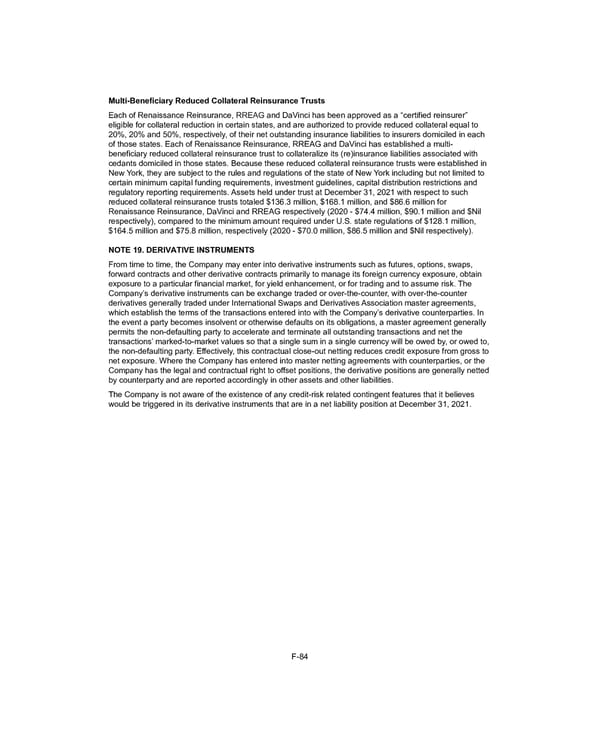Multi-Beneficiary Reduced Collateral Reinsurance Trusts Each of Renaissance Reinsurance, RREAG and DaVinci has been approved as a “certified reinsurer” eligible for collateral reduction in certain states, and are authorized to provide reduced collateral equal to 20%, 20% and 50%, respectively, of their net outstanding insurance liabilities to insurers domiciled in each of those states. Each of Renaissance Reinsurance, RREAG and DaVinci has established a multi- beneficiary reduced collateral reinsurance trust to collateralize its (re)insurance liabilities associated with cedants domiciled in those states. Because these reduced collateral reinsurance trusts were established in New York, they are subject to the rules and regulations of the state of New York including but not limited to certain minimum capital funding requirements, investment guidelines, capital distribution restrictions and regulatory reporting requirements. Assets held under trust at December 31, 2021 with respect to such reduced collateral reinsurance trusts totaled $136.3 million, $168.1 million, and $86.6 million for Renaissance Reinsurance, DaVinci and RREAG respectively (2020 - $74.4 million, $90.1 million and $Nil respectively), compared to the minimum amount required under U.S. state regulations of $128.1 million, $164.5 million and $75.8 million, respectively (2020 - $70.0 million, $86.5 million and $Nil respectively). NOTE 19. DERIVATIVE INSTRUMENTS From time to time, the Company may enter into derivative instruments such as futures, options, swaps, forward contracts and other derivative contracts primarily to manage its foreign currency exposure, obtain exposure to a particular financial market, for yield enhancement, or for trading and to assume risk. The Company’s derivative instruments can be exchange traded or over-the-counter, with over-the-counter derivatives generally traded under International Swaps and Derivatives Association master agreements, which establish the terms of the transactions entered into with the Company’s derivative counterparties. In the event a party becomes insolvent or otherwise defaults on its obligations, a master agreement generally permits the non-defaulting party to accelerate and terminate all outstanding transactions and net the transactions’ marked-to-market values so that a single sum in a single currency will be owed by, or owed to, the non-defaulting party. Effectively, this contractual close-out netting reduces credit exposure from gross to net exposure. Where the Company has entered into master netting agreements with counterparties, or the Company has the legal and contractual right to offset positions, the derivative positions are generally netted by counterparty and are reported accordingly in other assets and other liabilities. The Company is not aware of the existence of any credit-risk related contingent features that it believes would be triggered in its derivative instruments that are in a net liability position at December 31, 2021. F-84
 2021 Annual Report Page 226 Page 228
2021 Annual Report Page 226 Page 228